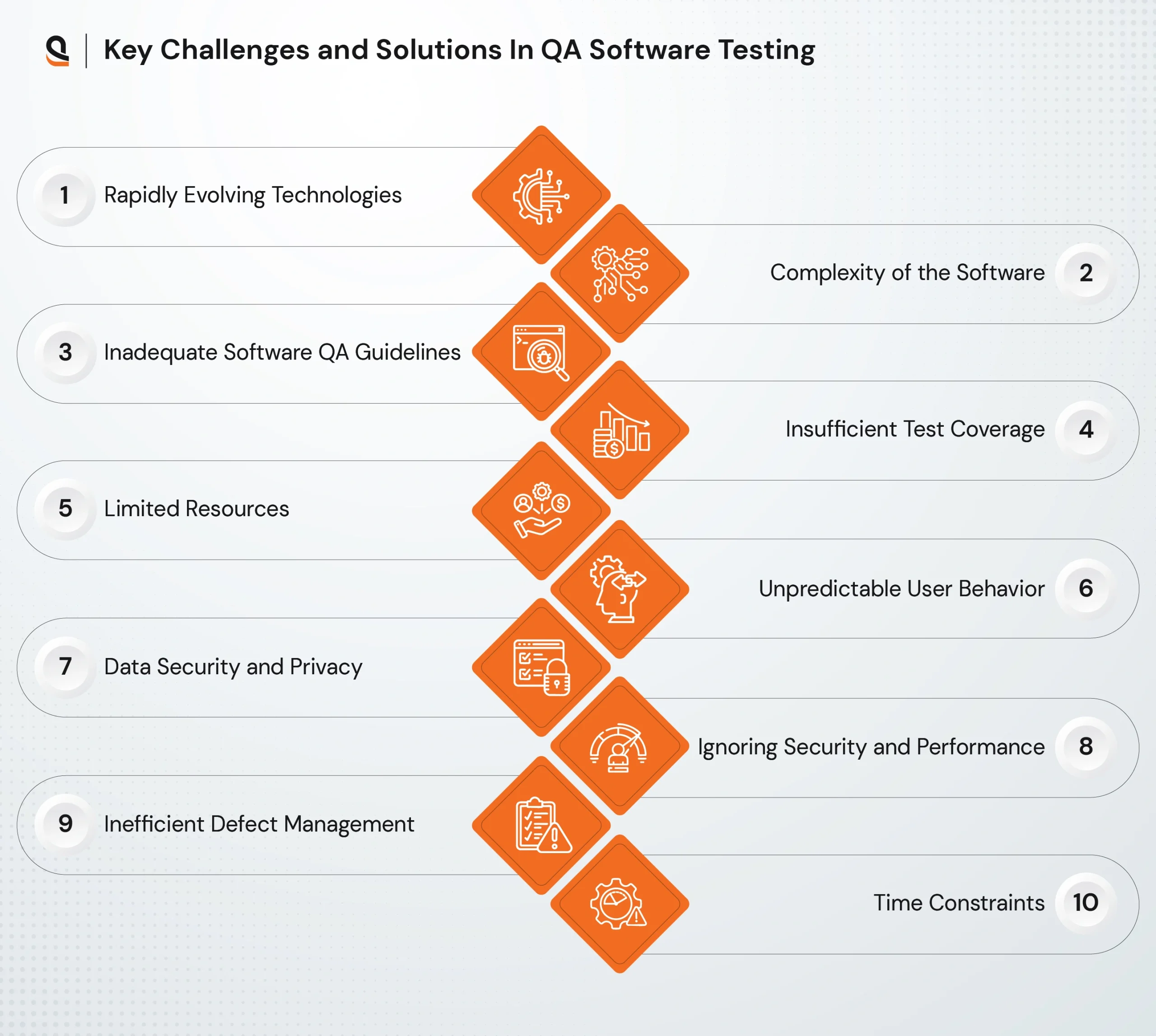Software development phases like planning and execution keep on evolving depending on the software’s requirements, tech stack, development team approach, and other aspects. The evolving software development cycles are also redefining the software quality assurance (QA) process, approach, and execution. QA, when done right, enhances software performance, minimizes errors, and promotes efficiency with a better user experience.
According to a research report by the IBM System Science Institute, if the defects get fixed during the early stages of designing and coding, the testing costs around 15x, while fixing them during the maintenance phase (after release), it costs 100 times.
Software Testing and QA Services help the team in ensuring each iteration is error-free and that software meets business expectations. The software testing services and QA landscape is growing with increased demand for multiple types of testing as businesses are emphasizing cybersecurity, risk compliance, and performance.
Software quality assurance testing is a multi-faceted process that poses various types of testing challenges listed below.
QA Testing Challenges and How to Solve Them
Rapidly Evolving Technologies
Challenge: The evolving approach of software development and the introduction of new tools, frameworks, platforms, and methodologies have been challenging for QA teams. It becomes complex and challenging to cope with the evolving challenges while ensuring seamless integration with the existing systems. Not adapting new technologies, learning, strategies, and methodologies can lead to inefficiencies and quality assurance in software testing.
Solution: Through regular training and adopting a continuous learning approach, our QA team stays updated with new technologies, strategies, and trends. We continue to conduct pilot projects to evaluate the effectiveness of the new tools and ensure that they align with our software testing services and expectations.
Complexity of the Software
Challenge: Most of the software, especially enterprise-level software involves multiple components, modules, APIs, features, microservices, and third-party integrations that create complex interdependencies. And, a defect in any one aspect or module of the architecture can affect other functionalities, making debugging and testing more challenging as well as complex. Maintaining performance and security is challenging for QA teams while ensuring smooth integration across multiple layers of software.
Solution: For isolated testing before integration, our QA team breaks down applications into individual components following a modular test strategy. Our team validates workflows across interconnected systems to ensure performance and functionality, leveraging an end-to-end automated testing strategy. We track changes effectively and prevent issues from propagating with clear and detailed documentation of dependencies, system architecture, and test scenarios as part of our software testing and QA services. This approach ensures faster issue detection, smoother integrations, and greater confidence in every deployment.
Inadequate Software QA Guidelines
Challenge: The unavailability of detailed and clear software quality assurance guidelines impacts the overall testing process, making it slow and inefficient. A lack of well-documented QA guidelines leads to inconsistent testing practices, overlooking test scenarios, missed defects, and misunderstandings. It not only impacts the quality assurance in software testing but also slows down development progress and delivers a compromised user experience due to undetected bugs in the software.
Solution: Our software testing and QA team is equipped with detailed and comprehensive QA guidelines required to deliver software aligning with business requirements. The guideline includes quality-centric details such as test plans, test types, test cases, test strategy, test data, etc., in our QA process. We emphasize detailed and continuous documentation throughout the software development cycle.
Insufficient Test Coverage
Challenge: Neglecting test coverage in software testing services results in repercussions that range from operational disruptions to strategic setbacks. Test coverage is important as it helps determine whether test cases cover the application code. It also helps determine how much code is exercised when those test cases are run. Inadequate test coverage remains a critical challenge for QA teams as it escalates technical debt due to undetected bugs.
Solution: Our team adopts an agile testing approach that evolves with the project’s progress and continuously updates the tests, getting them reflected in requirements. We leverage advanced test management methods to enhance efficiency and establish clear, tangible objectives for test coverage. We prioritize testing based on high-risk areas, implement different testing techniques, and monitor test coverage metrics to track the percentage of code covered by tests to identify gaps and areas for improvement in our software quality assurance strategy.
Limited Resources
Challenge: Quality assurance in software testing with limited resources can significantly impact the quality and the software development cycle. With a lack of resources, it becomes difficult for testing teams to conduct software QA in the early stages of the development cycle. Not conducting software testing and QA services from the beginning results in recurring defects and high additional expenses resulting from late error detection. Additionally, limited technical resources lead to improper and insufficient testing, which lacks automated and in-depth testing.
Solution: We implement software quality assurance and testing from the very beginning, following complete QA guidelines and clearly defining the project scope and requirements. As an enterprise software development partner, we don’t compromise on testing — every module gets a dedicated QA resource to ensure it’s error-free and nothing falls through the cracks. We also use the latest tools and technologies to keep our QA practices sharp and future-ready.
Unpredictable User Behavior
Challenge: It is difficult for QA professionals to predict how users will interact with the software as it serves a diverse audience. Usability issues or unexpected failures in real-world conditions result from failure in capturing edge cases when traditional testing methods are followed.
Solution: Before full-scale deployment, we conclude beta testing and user feedback to spot usability issues. We monitor user behavior by integrating analytics tools to refine software functionalities based on actual usage data. If needed, we implement crowd-sourced testing with a diverse set of testers to identify edge cases and enhance software quality assurance and performance.
Data Security and Privacy
Challenge: Ensuring data security and compliance, such as HIPAA updates, AGDPR, and CCPA, is challenging as well as essential in a testing environment. If proper security strategies and practices are not followed, it increases the risk of data breaches and regulatory violations that can lead to legal and financial consequences.
Solution: Our team implements data masking techniques to safeguard sensitive information and ensure data integrity and compliance. Our testing environments are secured with strict access controls and encryption. Our software testing services practice includes regular audits to identify potential risks and enforce compliance with industry regulations.
Ignoring Security and Performance
Challenge: Quality assurance in software testing is a multifaceted process where every aspect contributes to the overall performance and quality of software. Prioritizing only functional testing and ignoring security testing, performance testing, load testing, or stress testing can cost unprecedentedly to the software quality, performance, security, and efficiency. Apart from deprioritizing security and performance testing, not having dedicated security and performance testers, or testers with the necessary skills to design and execute effective tests, can result in missed issues, data breaches, and system crashes.
Solution: Our team conducts 360-degree testing where every aspect of software testing services is covered. Apart from functional testing, we also emphasize security testing, performance testing, load testing, and stress testing to ensure the optimal performance of software in dynamic conditions. We allocate dedicated security and performance testers to integrate testing throughout the development cycle, utilizing automated and the latest tools for top-tier software testing and QA services.
Inefficient Defect Management
Challenge: Effectively identifying, prioritizing, and tracking defects while ensuring clear communication between testers and developers is a testing challenge for the QA team. Lack of root cause analysis and proper priority assessment can result in delayed product delivery and potential issues in the software. Inefficient defect management can result in an exceeded Cost of Quality (CoQ) to the organization, impacting the budget and overall cost of the software.
Solution: We include clear defect reporting guidelines and implement prioritization techniques for efficient and effective defect management. During our software testing and QA services, we foster strong communication channels between testers and developers. Our software quality assurance process encourages developers to investigate the root cause of defects to prevent recurrence, utilizing robust defect management and tracking tools.
Time Constraints
Challenge: Compressed development cycles, Agile methodologies, and concurrent development make it difficult to conduct comprehensive testing. Limited time for QA leads to incomplete test coverage, increasing the risk of defects in production. Strict deadlines force teams to prioritize speed over quality, resulting in a compromised user experience.
Solution: Our QA team integrates agile iterative testing to validate features early and frequently, ensuring defects are caught before deployment. We leverage test automation for repetitive and regression testing, accelerating the QA process. Additionally, we implement risk-based testing, focusing on critical functionalities that impact system stability and user experience. These strategies help balance speed and quality, ensuring timely and reliable software releases under our software testing services model.
Why is AQe Digital the Preferred Software Testing and QA Partner?
At AQe Digital, our team follows a stringent enterprise software development process using advanced tools and technologies to deliver the best quality software.
Comprehensive Testing: Our team implements a comprehensive QA framework covering functional, performance, security, usability, and automation testing to deliver robust software through our software testing and QA services.
Industry-Specific Expertise: With experience across manufacturing, healthcare, retail, and more, AQe Digital tailors its software testing services to meet the unique requirements of different industries.
Seamless Integration & Continuous Testing: Our software quality assurance process integrates seamlessly with CI/CD pipelines, ensuring real-time testing and faster releases without compromising software quality.
Proven Track Record with 93% Client Retention: Our commitment to delivering high-quality software testing services has resulted in long-term partnerships and collaborations with global clients.
Conclusion
Tackling QA challenges is essential to deliver reliable, efficient, and high-quality software. Understanding and solving QA testing challenges streamlines the entire software development cycle. Enabling the QA team to work with full potential ensures the dependability, functionality, reliability, and security of the software. At AQe Digital, we provide comprehensive software testing and QA services, guaranteeing that software of any size excels in quality, performance, functionality, and security.



